The upcoming Hunter’s Moon reminds us of the many ways we can enjoy observing our humble satellite.
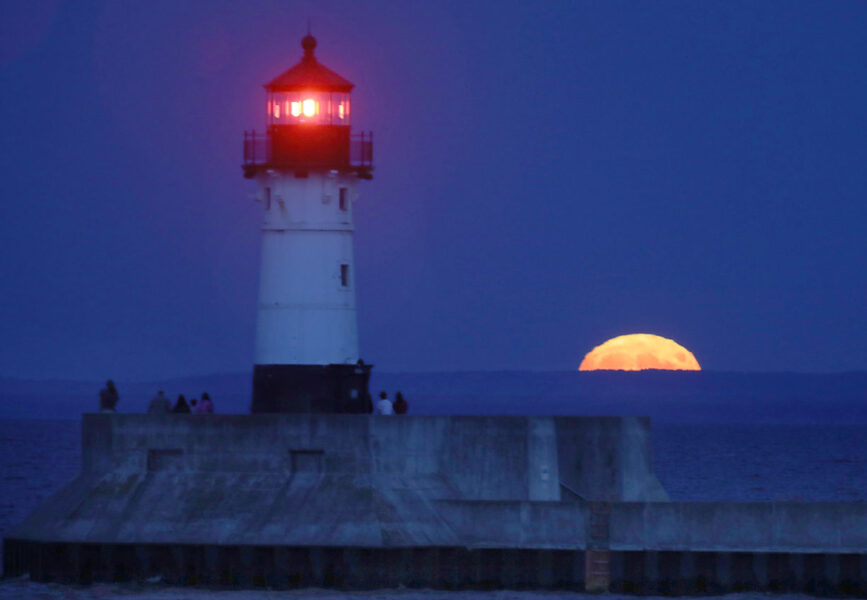
Bob King
I know, I know. Lots of us use full-Moon-time to catch up on sleep. We recoil at the sight like Dracula confronted with a crucifix. Not only is the sky awash with light, but direct-on, shadowless lighting, which occurs at full Moon, transforms our satellite into gray-and-white mush. But can it be worth it to observe the full Moon? You know the answer — yes!
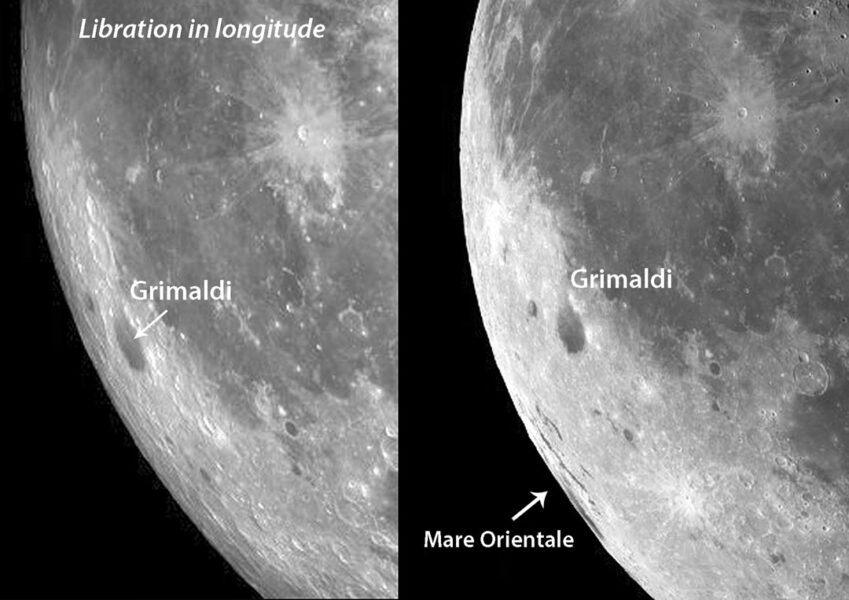
Bob King
Full moons not only illuminate the peculiarities of Earth's atmosphere, but this particular one presents a fine opportunity to see several limb-hugging lunar seas you may have ignored in the past — Humboldtianum, Australe, Smythii, and Marginis. Libration, a cyclical nodding and swaying of the Moon in latitude and longitude caused by its tipped axis and variable orbital speed, can sometimes tilt these little-observed maria out of view. But from October 4–9, favorable circumstances swing them back into visibility. More on this in a moment.
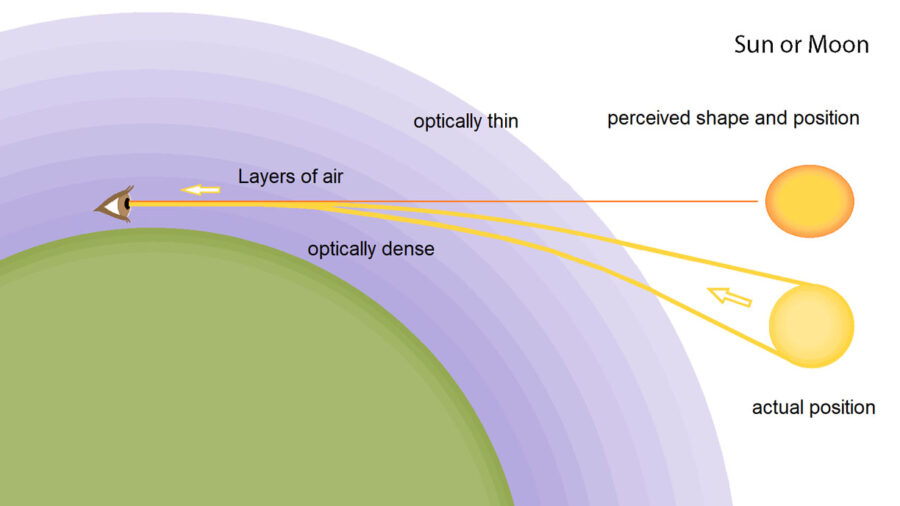
Sciencia58 / CC BY-SA 4.0
Let's begin at the beginning — moonrise. If you're lucky enough to find spot with a view all the way down to the horizon, you can briefly observe the Moon before it even rises. Air acts like a prism that bends or refracts light. Refraction is greatest at the very bottom of the atmosphere where the air is densest, amounting to 34′ or better than a full-moon diameter. When the bottom edge of the rising Moon appears to touch the horizon, in truth it's not even there. If you could remove the atmosphere at that moment you'd see blank sky! Click here to determine the time of moonrise for your location so you can experience the illusion in person.
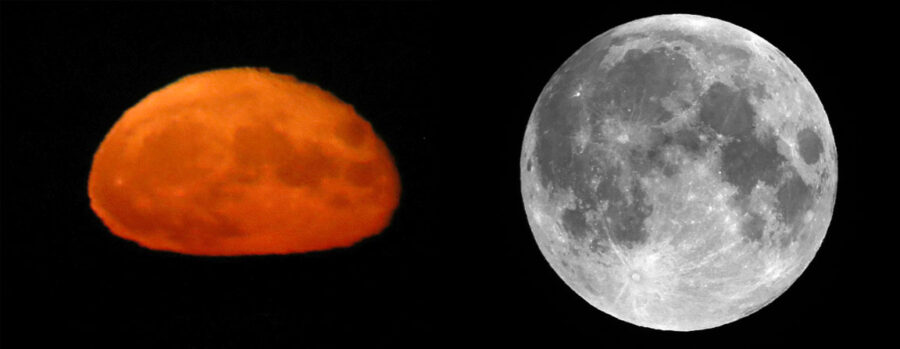
Bob King
That's not all. The bottom of the Moon lies slightly closer to the horizon where it suffers more refraction than the top. The denser air "lifts" the lower limb upward, flattening the lunar circle into something resembling a watermelon. This indignity persists until the Moon reaches a sufficient altitude for refractive effects to lessen in the thinning air — typically within 15–20 minutes. At 10°, refraction amounts to just 5.3′ and less than 1′ at 45°.
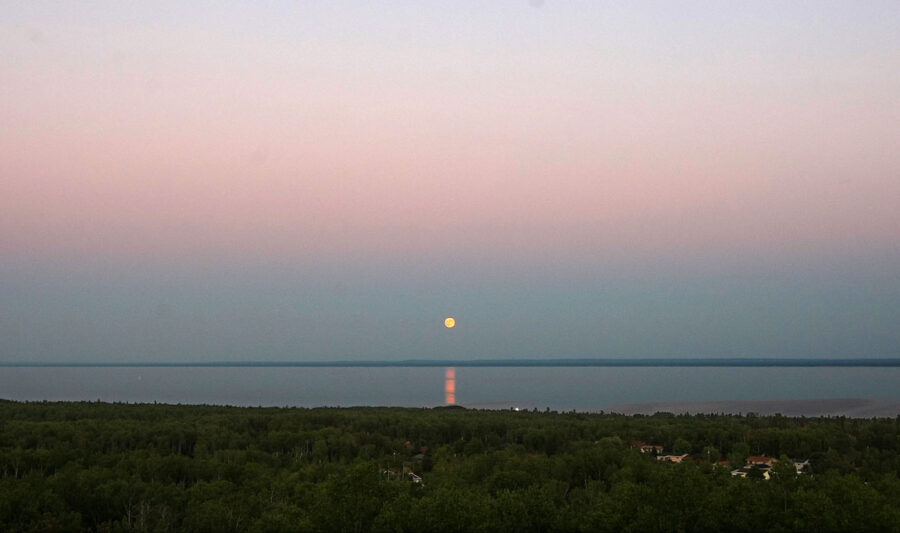
Bob King
Not only does the lens-like nature of the dense, lower atmosphere bend light, it scatters away many of the Moon's spectral colors, the ones that combined would otherwise make it appear white. Violet, blue, and green get the boot, leaving yellow, orange, and red to dominate — the reason the Moon, the Sun, and even the Milky Way (in time exposure photos) appear orange when near the horizon.
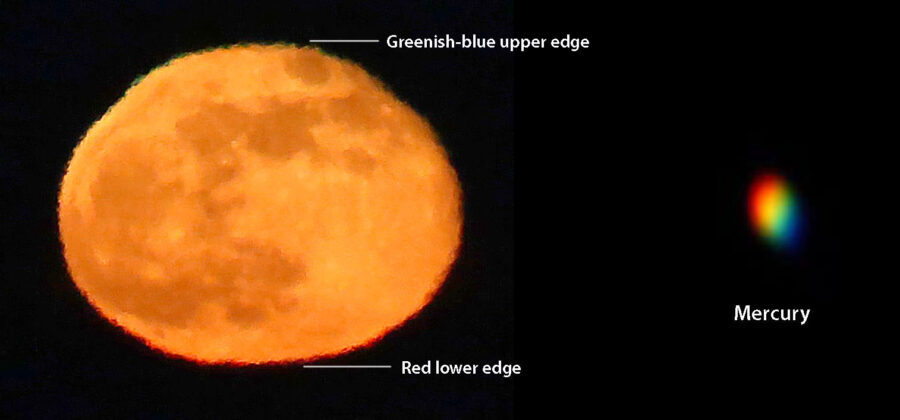
Left: Bob King; right: Austin Jarboe
In addition to bending and scattering light, the atmosphere also spreads out the light of bright stars and planets into mini-rainbows and creates colored fringes around the edge of the Moon. Dispersion combined with atmospheric turbulence is responsible for the frenetic and colorful twinkling of bright, low-hanging stars such as Sirius.
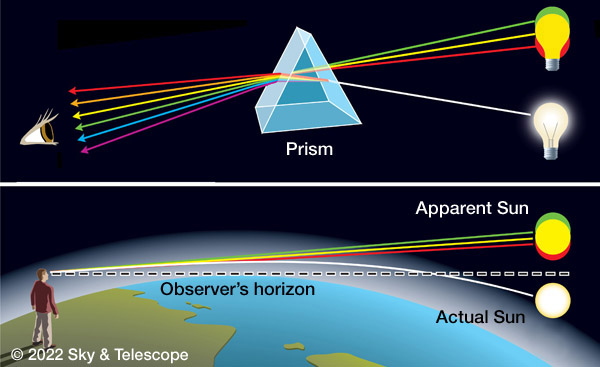
Sky & Telescope / Casey B. Reed
Lunar dispersion is too subtle to spy with the naked eye, but binoculars will readily show the fringes within 5–10 minutes of moonrise and moonset when conditions are right. That means observing a bright moonrise in a relatively dark sky, say in mid- to late twilight, when the contrast between the limb and sky background is strong.
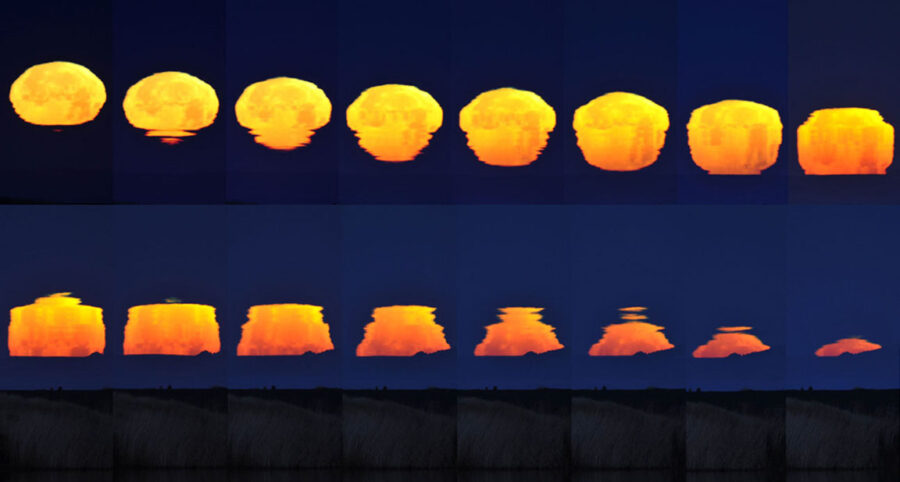
Watch for additional atmospheric effects such as inferior and superior mirages, towering (exaggerated vertical dimension), and ziggurat-like "steps" cutting into the lunar limb, all caused by light fighting its way to your eyes through multiple layers of air of different density, temperature, and refractive index. Our atmospheric prism can be fluid and unpredictable!
Since the Moon never stops moving, full Moon lasts only a moment before the waning cycle begins. On October 9th, that occurs at 20:55 UT (4:55 p.m. EDT), the instant our satellite will lie directly opposite the Sun in the sky and appear fully illuminated. But recall that the Moon-Earth-Sun lineup is only exact during a total lunar eclipse, when the Moon slides directly behind the Earth into its shadow. Otherwise the queue is slightly askew, with about 99.9 percent of the Moon illuminated and 0.1 percent in darkness along one or another limb. The naked eye can't detect this bit of limb shading (a.k.a the terminator), but the telescope can.
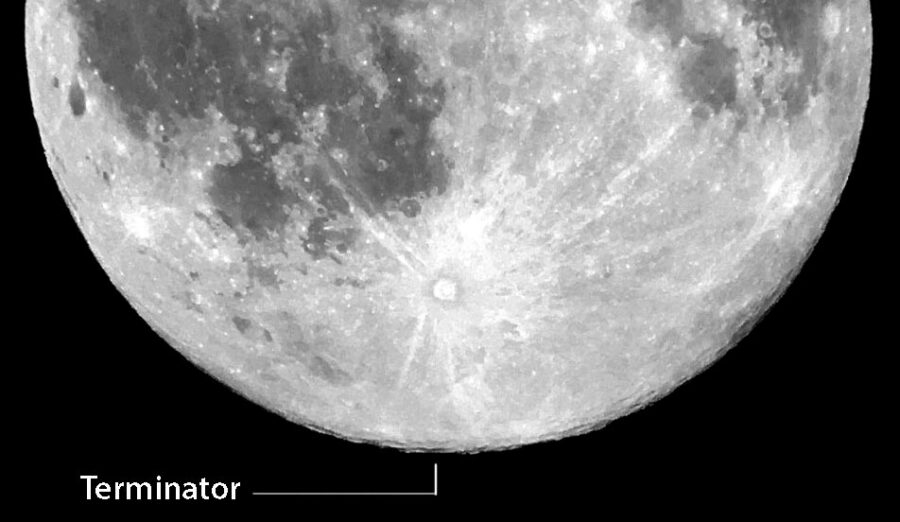
Bob King
We see the terminator at full Moon most months because the Moon's orbit is inclined 5.1° to the plane of Earth's orbit. During each lunar cycle the Moon weaves north and south of the ecliptic like a diving duck that comes up for air after each fresh catch. When it's north of that great circle, the northern limb is fully illuminated, with the terminator rounding out the southern limb. When it dips to the south, the shadow edges the northern limb.
If you observe the Moon say, 8 hours before full, you'll still see shading along its western edge. But if you happen to observe the Moon within an hour or two of full phase, you'll spot the terminator running along the northern or southern limb on its way back east. I love the sight — a tantalizing moment not unlike the sensation you felt on a teeter-totter when you and your partner sat poised, momentarily in balance, before one or the other gained the upper hand.
Observers in the Eastern Hemisphere are best positioned to see the terminator transition this month. Next month, the Moon will be in total eclipse. On December 7th, Western Hemisphere observers will be favored, with full phase at 11:08 p.m. EST.

Left: Joseph Karl Stieler, right: Maull & Polybank
No survey of the Moon through a small telescope would be complete without a visit to the four lunar seas straddling the eastern limb. Two of them are the only maria named for real people — the early 19th-century German explorer and polymath Alexander von Humboldt, immortalized in Mare Humboldtianum, and William Henry Smyth, a 19th-century British Royal Navy officer who devoted his later years to astronomy. Smyth wrote the two-volume guide A Cycle of Celestial Objects. His spirit now resides in Mare Smythii (SMITH-ee-ai).
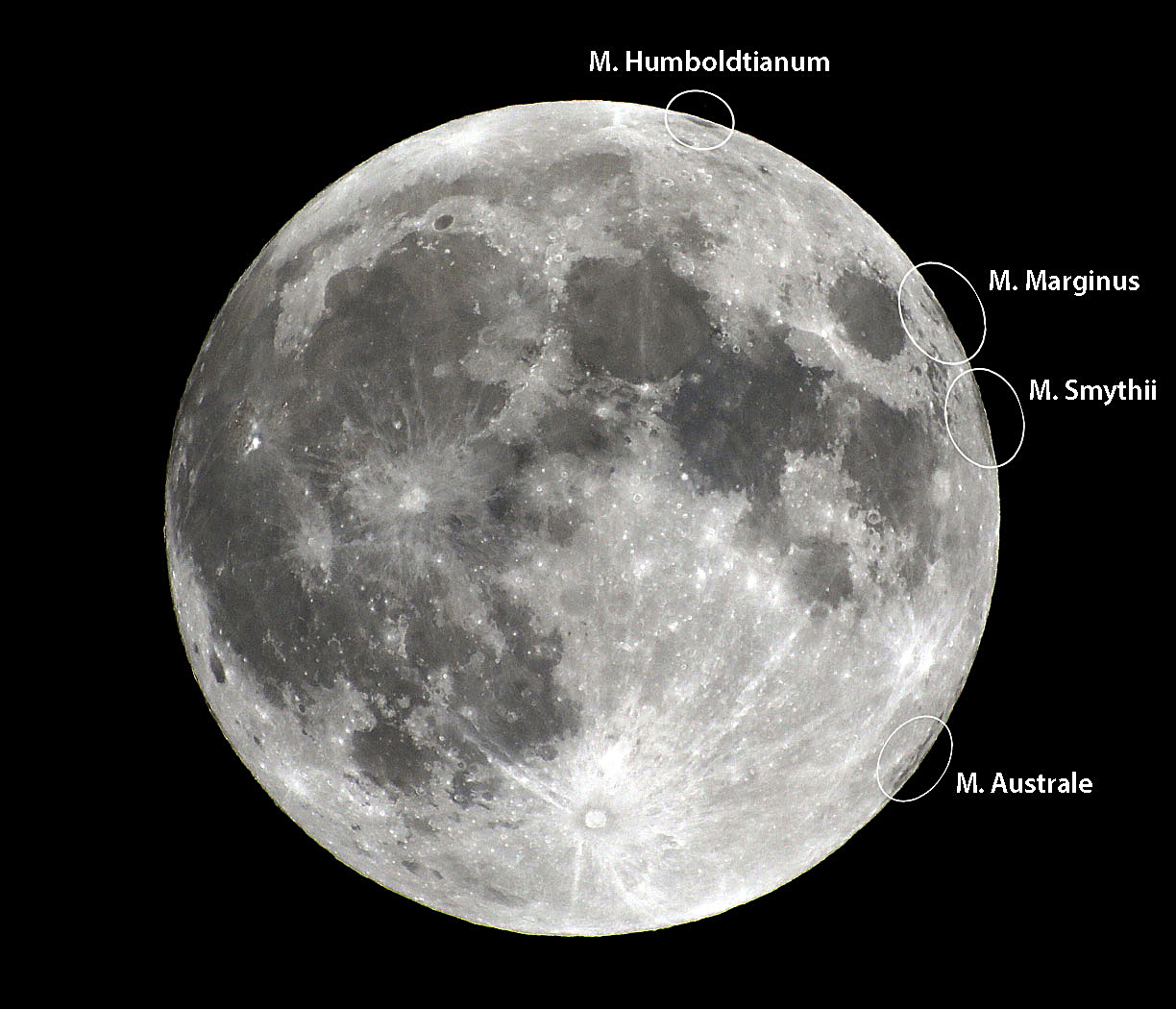
Bob King
Mare Humboldtianum, 230 kilometers (140 miles) wide, looks like a gray, oval patch tucked into the Moon's northeastern limb. It occupies a much larger basin spanning 600 kilometers (375 miles) across that was punched out by an asteroid 3.9 billion years ago. Lavas belching from the lunar interior 500–200 million years later partially filled the depression to create the mare.
Moving south we next encounter Mare Marginis (Sea of the Edge) located directly across from the prominent oval of Mare Crisium. Compared to most of the nearside maria, this sea has an irregular outline and no obvious associated impact basin. Circular features within Marginis appear to be flooded craters, a clue that the lunar crust here may have been thin enough for lava to breach the surface and flood lower elevation lunar crust.
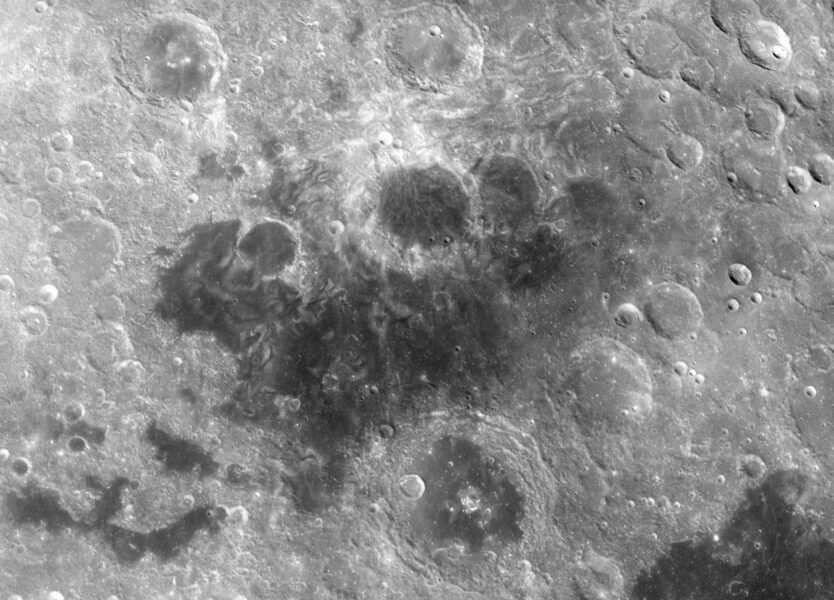
NASA
If you examine the mare carefully at 150× or more you might be able to make out some of the peculiar white wisps shown in the Apollo 16 photo above. These may be connected to the mare's location at the antipode of the massive impact that formed the bull's-eye of Mare Orientale. Alternatively, they may be related to the Reiner Gamma swirl, an enigmatic magnetic anomaly far away in Oceanus Procellarum.
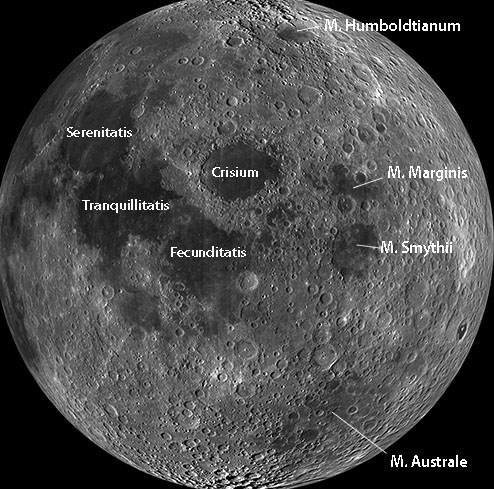
NASA / LRO
From here we shove off past the lava-flooded crater Neper (137 kilometers, 85 miles), located on the rim of Mare Marginis, to the Sea of Smyth. The Smythii Basin, which cradles the mare, is truly ancient, dating back to between 3.9 and 4.5 billion years. Its circular form and outer ring indicate an impact origin. The younger mare is about 374 kilometers (232 miles) across and has a mottled light-and-dark gray texture and lens-like shape due to extreme foreshortening at the limb.
Mare Australe (Southern Sea) tilts into view along the southeastern limb around October 5th and shows best on October 9th just before it succumbs to the encroaching terminator. Look for a skinny, dark oval due east of the prominent crater Janssen and its famous rill. Seen from orbit, the 997-kilometer-wide (620 miles) mare displays an uneven surface pocked with lava-flooded craters. The basin itself appears to have been nearly destroyed by bombardment prior to the appearance of the mare, which rose through faults in the Moon's crust between 3.8 and 3.2 billion years ago.
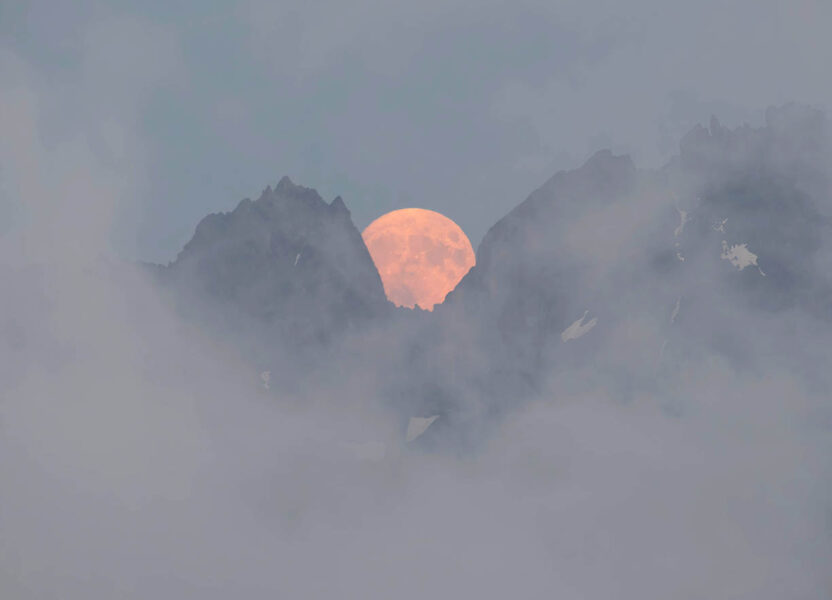
Richard Klawitter
With our survey concluded, I feel an apology is in order for giving you yet more reasons to stay up late when you should be sleeping.
 6
6








Comments
bob kelly
October 5, 2022 at 6:53 pm
The Dec 7th Full Moon will be right next to Mars at opposition, so now you've given us another great thing to look for when we are teasing out Mars from next to the Moon! (See Joe Rao's note in December's issue.)
You must be logged in to post a comment.
Bob KingPost Author
October 6, 2022 at 1:00 am
Hi Bob,
Yes, I can't wait for the Mars occultation. Timing couldn't be better!
You must be logged in to post a comment.
Chris-Schur
October 9, 2022 at 1:58 pm
Amazing moon shots Bob! You have to be in the right place at the right time AND know how to handle a camera. Very impressive. We saw something once in Arizona at sunrise that Ill never forget involving the full moon - A monsoon rain storm had just passed and there was a huge rainbow in the west, a full arc with the center cleared out to show the full moon inside. It was right in the middle of the arc! I didnt have a camera, but that sight was one of the most memorable Ive ever seen involving the full moon. Thanks again for such an informative article.
You must be logged in to post a comment.
Kevan Hubbard
October 12, 2022 at 6:47 am
The Lunar terminator line must only be a tiny bit below the resolution of the human eye as I can detect it using my smallest telescope that being my 5x10 Zeiss Mini Quick monocular.A fascinating article and nicely explains why the Moon and Sun look so big when they are rising/setting.I have never noticed an increase in size with Jupiter and Venus rising/setting but there probably is but it'd be too slight to notice.
You must be logged in to post a comment.
Walter Clayton
October 16, 2022 at 10:06 am
Hey Mr. Bob!
Reading about the Prism effect and the atmosphere reminded me of a time when a friend of mine and I saw Alpha and Beta Centauri from Savannah, GA. at 32n
Both, at best, Transit the Meridian at about -2 degs, JUST too low to see from there, but, we had an observing site that had an all but flat southern horizon. It was a cool night, so, we actually could see objects very close to the horizon already. It took a few calculations and star hopping, but, there they were!
We can regularly see Archernar clear the horizon at about 1 deg above the horizon from this location too.
Walter Clayton
s/v Always Home
You must be logged in to post a comment.
Bob KingPost Author
October 16, 2022 at 10:47 am
Hi Walter,
Thanks for letting us know it's possible. It sounds like you enjoy hunting horizon extremes as much as I do!
You must be logged in to post a comment.
You must be logged in to post a comment.